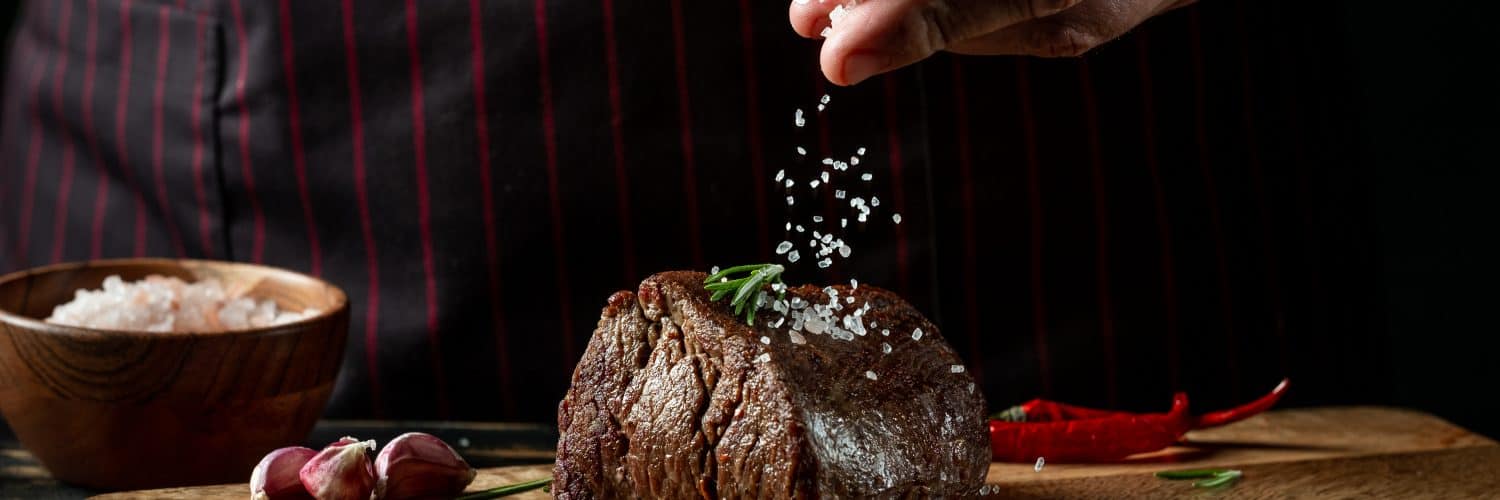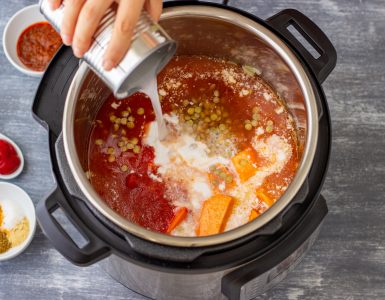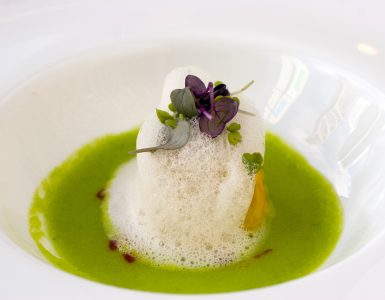You’ve had it drilled into your head over and over. “Season your food!” “Don’t forget to salt!” “Did you taste for salt?!” Even if you haven’t had the pleasure of working in a restaurant kitchen and personally getting these comments, you’ve picked up the importance of seasoning well either through your own experience or through the ubiquitous comments on cooking shows.
Figuring out whether to salt before or after sous vide is a little more complicated, though. When food is cooking for this long, salting it first has a different effect than it would if you were just going to toss it in a frying pan and serve it in a few minutes. Read on to learn more, including why we (usually!) don’t suggest salting first and which food is the exception to this rule.
This article is part of a series of tests and experiments to help you sous vide the perfect steak. Check out that article to learn more about the entire process!
Table of Contents
What Happens When You Salt Your Food
First and foremost: the salt makes your food delicious! But you already knew that.
Let’s talk science for a minute. Thanks to the process of osmosis, salt draws water out of cells. You can think of this as the water inside the cell wanting to keep everything equally salty. If there’s more salt outside the food than inside, water will come out of the food to try to achieve a balance and create an equal level of saltiness everywhere. (This is oversimplified, but works as a way to envision it for us non-science people!)
If you’ve ever tried to make beet chips in the oven or eggplant Parmesan, you may have already used this technique. Salting sliced vegetables helps to draw out the moisture, which then changes how they behave during cooking and leads to different textural results at the end.
And while eggplant is probably the most common example of this technique, the same general theory applies to most other foods as well. This also includes meats, not just plants.
The Impact of Salt in Sous Vide Cooking
Now that you understand that salt draws out moisture, we can talk about how this applies to sous vide cooking specifically.
The big factor to keep in mind here is that sous vide cooking generally occurs over a prolonged period. If you season a steak, throw it in a hot cast iron pan, and cook it for a couple of minutes on each side, the salt doesn’t have time to draw out much water.
On the other hand, if your food is coated in salt for a period of several hours or more, that’s a lot of time for those water cells to try to achieve a balance by leaking out. Over this amount of time, you can see some pretty serious differences in texture.
To be clear, a lot of foods will tend to give off some liquid during cooking regardless of whether they’re salted. But the salt speeds up the process and typically results in more liquid being pulled from the food.
So When Should I Add Salt?
As with most things in the kitchen, there’s no firm one-size-fits-all answer! We can’t say that you should always salt first or never salt first, because it depends on what you want to achieve.
Think of it this way: if you want to draw moisture out of your food and leave it drier or firmer after the cooking process, we would generally recommend salting first.
If you want to leave as much moisture as possible in your food and leave it juicy or tender after cooking, we would generally recommend salting after the sous vide bath.
With a few of the most common sous vide foods, the answer is pretty obvious one way or the other, and we’ll address these cases below. For a lot of preparations, though, it’s a matter of taste and experimentation.
Should I Salt Steak Before or After Sous Vide Cooking?
After! We’ve tested this extensively, using different cuts of steak and cook times to definitively establish whether to salt steak before or after.
We’ve consistently found that steak salted after sous vide cooking is somewhat more tender and juicy, so this is our recommendation. The difference is less noticeable than you might expect, but it’s definitely there.
As the science would suggest, salting steak before you cook it for several hours draws out more of the juices, resulting in a firmer (dare I say tougher) final product. This generally isn’t what one wants in a steak, so we absolutely recommend salting afterward.
We’ve also found that steaks salted before cooking develop more of a greyish hue through the cooking process. Most of this is disguised by searing, of course—but hints of grey show in the little patches that escape the full Maillard reaction.
An important note: in our various tests of salting steak before and after, we did find that the steaks that were salted before the sous vide bath developed a nicer seared crust than those salted after the bath (but before searing, of course). For us, this wasn’t worth the loss of juicy tenderness throughout the rest of the steak. But if your priority is a perfect sear, you may be the exception to the rule of salting steak afterward. Instead, consider salting before you sous vide your steak.
What About Fish? Should I Salt Before or After Sous Vide Cooking?
Before. Fish is one of the common exceptions to our general rule of salting after sous vide. This is because fish is naturally so delicate that it can end up becoming mushy or too soft after sous vide cooking.
Adding salt before you cook (whether that’s a sprinkle of salt immediately before or a longer brine) draws out some of the moisture and leaves the fish firmer. While you want tenderness with steak, this extra firmness helps the fish keep a nicer texture and avoid turning mushy.
Conclusion
There’s no hard-and-fast rule as to whether you should always salt before or after sous vide cooking. In most cases, you’ll need to make a judgment call. Do you want your food to be drier and firmer? If so, salt before. Do you want it to be juicier? Salt after.
As a general rule, we recommend salting red meat (including pork) after cooking it—unless your priority is a perfect sear rather than perfect tenderness. Fish is typically better if salted or brined before cooking, because this helps it retain a firmer texture. But now that you know the effects of salting food, you can make your own decisions on when to salt based on the results you’re going for.










